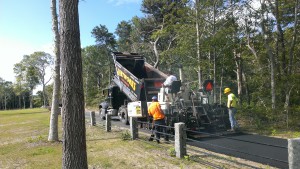Asphalt Pavement & Winter Paving
Asphalt Pavement & Winter Paving
 Most people know that asphalt contractors tend to be busiest between late spring and early fall, but not everyone is aware that asphalt paving jobs are frequently performed during the winter. Paving in cold weather is more challenging, but experienced contractors know that if the proper steps are taken, the quality of the pavement will be as good as pavement installed during the middle of the summer. However, it requires a bit of extra effort on the contractor’s part to ensure that the job goes as planned.
Most people know that asphalt contractors tend to be busiest between late spring and early fall, but not everyone is aware that asphalt paving jobs are frequently performed during the winter. Paving in cold weather is more challenging, but experienced contractors know that if the proper steps are taken, the quality of the pavement will be as good as pavement installed during the middle of the summer. However, it requires a bit of extra effort on the contractor’s part to ensure that the job goes as planned.
Asphalt Pavement & Winter Paving
Factors Affecting Winter Paving Jobs
If asphalt pavement is to be durable, it must be properly compacted. Compaction helps eliminate the pockets of air trapped in the mix that could result in weaker pavement if they remain. It is critical that compaction occur before the asphalt mix cools too much and becomes stiff or unworkable. The following factors determine how quickly compaction must occur.
• Ambient or air temperature
• Ground temperature
• Temperature of the mix at delivery
• Wind speed
• Amount of sunlight the pavement receives
• Thickness of the asphalt layer
The thickness of the asphalt layer is extremely important. The thinner the layer, the faster it will lose its heat. The relationship between thickness and heat retention is exponential rather than linear. For example, a 3-inch layer is twice as thick as a 1.5-inch layer, but the 3-inch layer will hold onto its heat about four times longer.
The ground temperature is also of critical importance. The laws of physics state that when a hot material is placed in contact with a cold material, heat is transferred until the temperatures of both materials are the same. The greater the temperature difference is between the two materials, the faster the temperatures of both will become equal. In other words, the greater the difference is between the temperature of the ground and the temperature of the mix, the less time the contractor will have to complete the compaction.
As the temperature of the mix at delivery is the starting point for determining how quickly cooling will occur, the contractor must monitor the mix temperature carefully. The ideal temperature depends on the type of mix as well as environmental factors, but most mixes are between 275 degrees and 325 degrees Fahrenheit.
The air temperature is not as critical as the ground temperature, but when winds are brisk, it can become more important. Strong winds allow heat to be lost through convection, so the asphalt is essentially cooling from both the top and bottom.
Sunlight can help the asphalt retain its heat longer, meaning that the asphalt will cool slower on a sunny day than when the skies are overcast. However, most of the time, sunlight has only a minor impact although it is certainly a factor that contractors consider.
If You Need Asphalt Paving in the Winter
At Dirtworks, we have been installing asphalt pavement in the Cape Cod area for over 20 years. We have the expertise to pave successfully in every season. We offer a full range of asphalt-related services, including asphalt paving and overlays, sealcoating, repairs, milling and parking lot striping. We also offer site work, excavation services and snow removal. If you have more questions about Asphalt Pavement & Winter Paving, or would like a free quote, submit the online form or call (508) 240-5541.
Dirtworks, The Premier Paving Contractor in Cape Cod!






